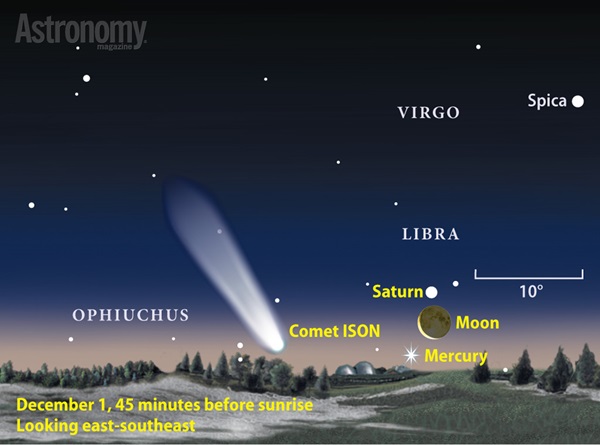Key Takeaways:
Astronomers discovered this comet before dawn September 21, 2012. As the first new comet detected during the second half of September that year, it received the designation “C/2012 S1.” And because the researchers who first spotted the object worked for the International Scientific Optical Network, it received that group’s acronym, ISON, as a secondary name. Although the “C/2012 S1” designation is more precise, most amateur and even many professional astronomers refer to it as “ISON” because it rolls off the tongue more easily.
The comet is making its first trip through the inner solar system. Its journey began eons ago when a star or interstellar cloud passed within a light-year or two of the Sun. This close encounter jostled the so-called Oort Cloud, a vast reservoir of icy objects that lies up to a light-year from our star and probably holds a trillion comets. ISON has been heading toward the Sun ever since.
By early October, the comet had brightened enough to show up nicely through medium-sized and large telescopes, and it sported a nice tail in images. By early November, ISON will appear against the background stars of southeastern Leo. This region rises more than four hours before the Sun and stands nearly 30° above the eastern horizon by the time morning twilight starts. If predictions hold, the comet should be a nice object through binoculars.
As ISON’s date with the Sun in late November nears, the comet picks up speed. It quickly moves into Virgo, where it has its sights set on that constellation’s brightest star, 1st-magnitude Spica. By the time the comet and star meet November 18, ISON should be within reach of naked eyes from a dark-sky location.
The comet’s relentless approach to the Sun during the next week brings it within the vicinity of two bright planets: Mercury and Saturn. The best view of this trio comes on the 24th, about 45 minutes before the Sun rises.
Comet ISON comes closest to the Sun (a position called “perihelion”) on November 28 — Thanksgiving Day in the United States. It then passes 1.16 million miles (1.86 million kilometers) from our star’s center, or just 730,000 miles (1.16 million kilometers) from its surface. If predictions pan out, the comet should then be about as bright as Venus, although it lies within 1° of the Sun. Be sure to carefully shield our star if you plan to look for the comet that day, and don’t even think about using optical aid.
Your best views of perihelion likely will come from NASA’s Solar and Heliospheric Observatory (SOHO). The spacecraft uses a coronagraph to block the Sun’s disk and reveal the solar corona and any other bright objects nearby, such as Comet McNaught (C/2006 P1) when it passed by in January 2007. ISON will appear in SOHO’s wide-field coronagraph for nearly four days and in the narrow-field instrument for about 10 hours around perihelion. (You can access current C2 and C3 images at sohowww.nascom.nasa.gov/data/realtime-images.html.)
After perihelion, ISON veers sharply to the north, and by December’s first week it re-emerges in the morning sky. The comet’s path takes it from northern Scorpius through Ophiuchus, Serpens, Corona Borealis, and into Hercules. While in Hercules starting around December 20, the comet passes within 5° of the great globular star cluster M13. Both objects will fit in the field of view of 7×50 binoculars. If predictions hold, ISON should glow around magnitude 5.4, half a magnitude brighter than the globular.
The comet continues its northward trek during the last 10 days of December. It passes from Hercules into Draco and ends the month on the doorstep of Ursa Minor. It will pass by Polaris, the North Star, during January’s first week.
If Comet ISON lives up to expectations, it should develop two tails emanating from a round glow. This photograph shows Comet Hale-Bopp from 1997. ISON may equal or even surpass Hale-Bopp, which nicely showed a comet’s major components.
The circular head, known as the “coma,” masks the comet’s nucleus. The nucleus is a ball of ice and dust that, in ISON’s case, measures roughly 3 miles (5 kilometers) in diameter. As sunlight hits the nucleus, the ices boil off, and the process liberates dust particles. This cloud of gas and dust forms the coma, which can span a million miles or more. Sunlight removes electrons from the ejected gas molecules, causing them to glow with a bluish color. The solar wind carries this gas away from the comet, creating a straight bluish gas tail. The ejected dust gets pushed away from the Sun more gently, so it forms a curving tail. The dust particles simply reflect sunlight, so the dust tail has a white to pale-yellow color. Although Comet McNaught didn’t show much of a gas tail when it achieved fame in 2007, it more than made up for it with a 30°-long curving dust tail.
Will ISON rival or beat Hale-Bopp and McNaught? The best way to find out is to plan a few observing sessions for this November and December. Even if ISON falls a bit short of greatness, goodness is a fine attribute when it comes to comets. For complete coverage of the comet, check out www.Astronomy.com/ISON.











